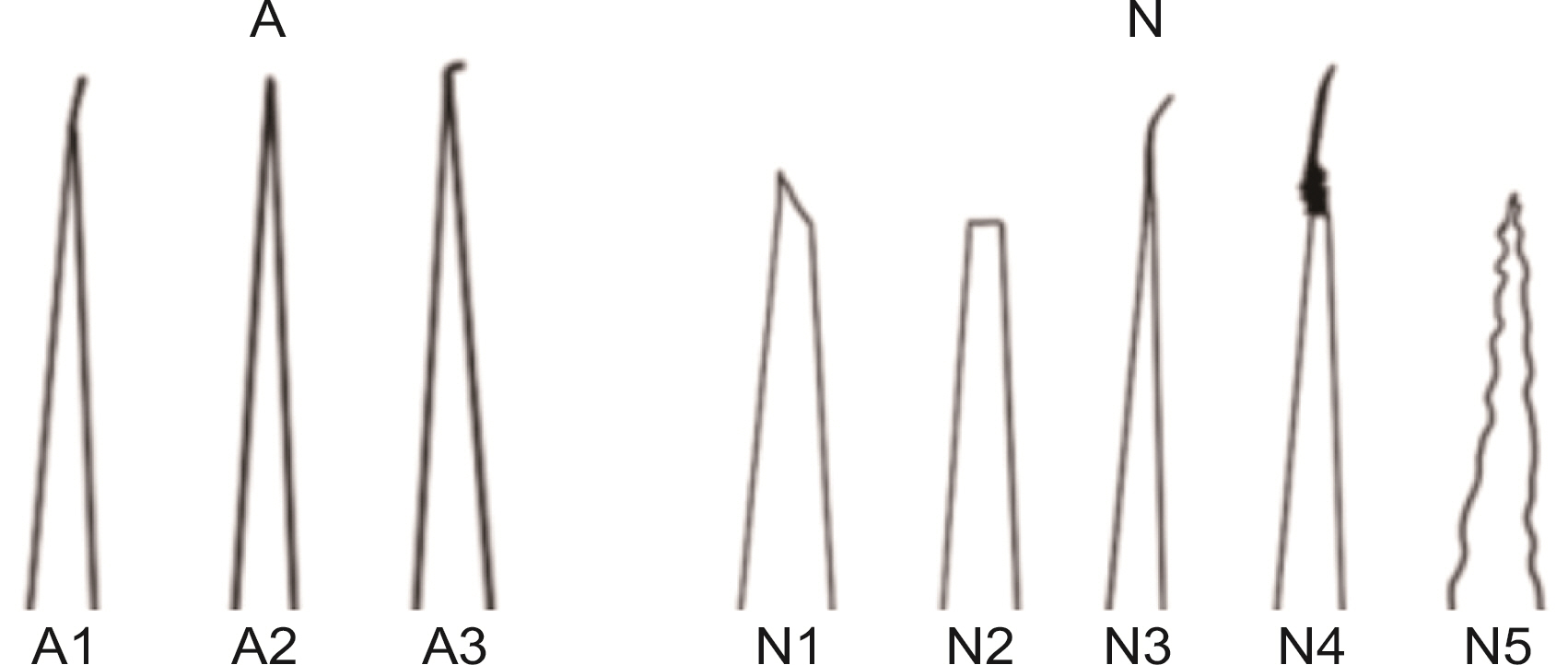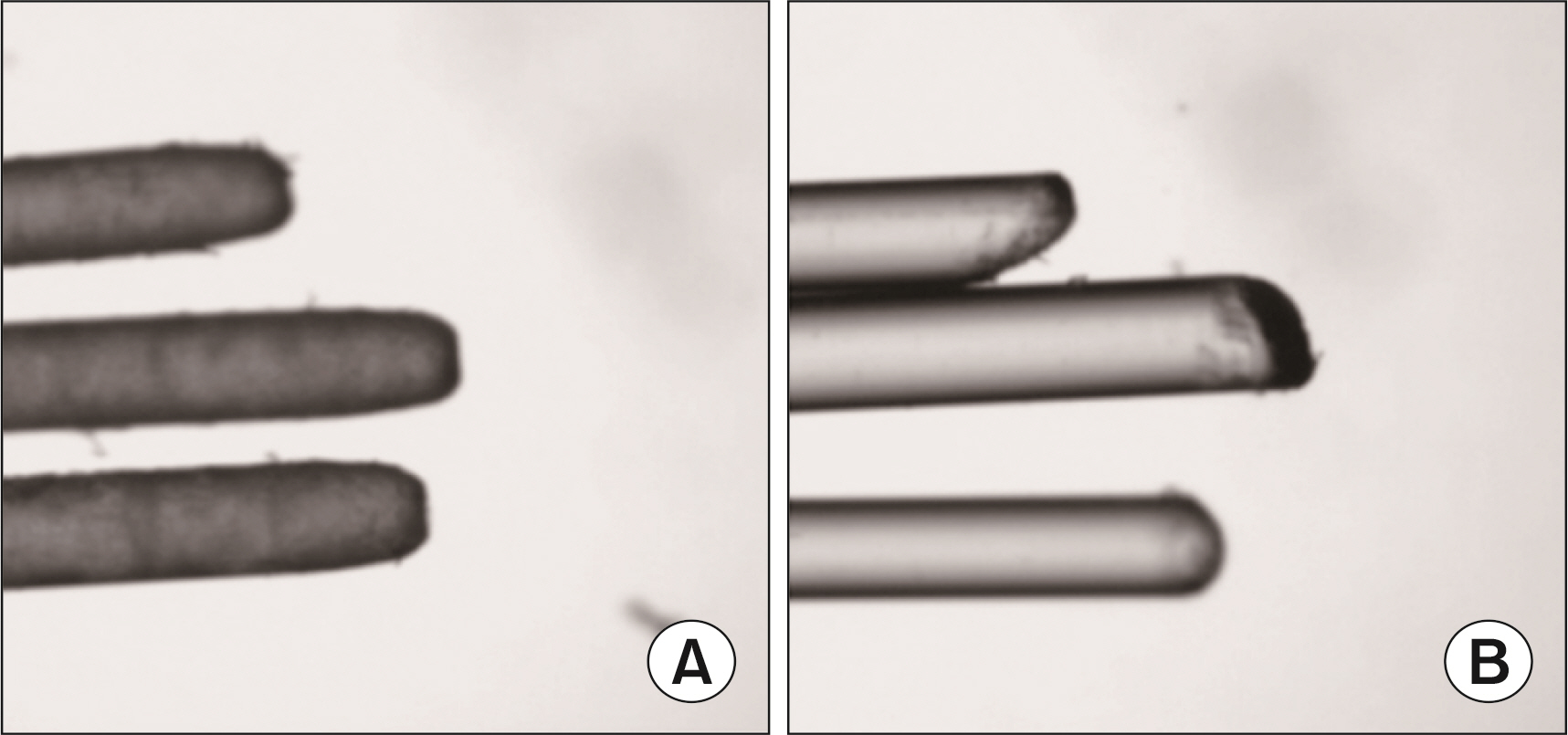J Korean Acad Oral Health.
2022 Dec;46(4):222-227. 10.11149/jkaoh.2022.46.4.222.
A study on the bristles of commercial toothbrush in Korea
- Affiliations
-
- 1Department of Preventive and Public Health Dentistry, Chonnam National University School of Dentistry, Gwangju, Korea
- 2Dental Science Research Institute, Chonnam National University School of Dentistry, Gwangju, Korea
- KMID: 2537818
- DOI: http://doi.org/10.11149/jkaoh.2022.46.4.222
Abstract
Objectives
This study aimed to investigate the bristle tip morphology of toothbrushes sold in the Korean market.
Methods
Tufts were taken from each of the 69 different toothbrushes that were selected. The bristle specimens thus prepared were observed under a phase-contrast microscope. The images taken by the microscope were then classified as round, tapered, or mixed. The proportion of acceptable rounded-end bristles and tapered bristles was then determined.
Results
Of the randomly selected 69 toothbrushes, 42 were domestic and 27 were imported. Of the domestic toothbrushes, the proportion of acceptable toothbrushes was 52.4%, whereas the corresponding proportion was 77.8% for imported products. In terms of classification based on tooth brushing techniques, 55.0% of all manual toothbrushes had round-ended bristles. Moreover, based on classification by age, 67.2% of the toothbrushes for adults were acceptable and 75.0% of tooth brushes for children were termed non-acceptable.
Conclusions
The majority of toothbrushes sold in the Korean markets have acceptable bristles. However, not one toothbrush had 100% acceptable bristles. The manufactures should improve their manufacturing processes to produce bristles of the intended quality.
Keyword
Figure
Cited by 1 articles
-
Microplastic chip occurrence at toothbrush bristle tips: an optical microscopy investigation
Seung-Hwa Jeong, You-Jin Cho, Eun-Joo Jun
J Korean Acad Oral Health. 2024;48(1):20-25. doi: 10.11149/jkaoh.2024.48.1.20.
Reference
-
References
1. Ranzan N, Muniz FWMG, Rösing CK. 2019; Are bristle stiffness and bristle end-shape related to adverse effects on soft tissue during toothbrushing? A systematic review. Int. Dent J. (3):171–182. DOI: 10.1111/idj.12421. PMID: 30152076. PMCID: PMC9379007.2. Hennequin-Hoenderdos NL, Slot DE, Van der Sluijs E, Adam R, Grender JM, Van der Weijden GA. 2017; Nov. The effects of different levels of brush end rounding on gingival abrasion: a double-blind randomized clinical trial. Int J Dent Hyg. 15(4):335–344. DOI: 10.1111/idh.12212. PMID: 26934834.3. Breitenmoser J, Mörmann W, Mühlemann HR. 1979; Apr. Damaging effects of toothbrush bristles end form on gingiva. J peridontol. 50(4):212–6. DOI: 10.1902/jop.1979.50.4.212. PMID: 374707.4. Caporossi LS, Dutra DA, Martins MR, Prochnow EP, Moreira CH, Kantorski KZ. 2016; Combined effect of the end-rounded versus tapered bristles and a dentifrice on plaque removal and gingival abrasion. Braz Oral Res. 30(1):e37. DOI: 10.1590/1807-3107BOR-2016.vol30.0037. PMID: 26981758.5. Versteeg PA, Piscaer M, Rosema NA, Timmerman MF, Van der Velden U, Van der Weijden GA. 2008; Tapered toothbrush filaments in relation to gingival abrasion, removal of plaque and treatment of gingivitis. Int J Dent Hyg. 6(3):174–82. DOI: 10.1111/j.1601-5037.2008.00284.x. PMID: 18768020.6. Gallob J, Petrone MD, Mateo LR, Chaknis P, Morrison BM Jr, Panagakos F, et al. 2016; Jun. Comparative efficacy of a soft toothbrush with tapered-tip bristles to an ADA reference toothbrush on gingival abrasion over a 12-week period. J Clin Dent. 27(2):48–53.7. Dörfer CE, von Bethlenfalvy ER, Kugel B, Pioch T. 2003; Cleaning efficacy of a manual toothbrush with tapered filaments. Oreal Health Prev Dent. 1(2):111–8.8. Lee HS, Jung HI, Kang SM, Kim HE, Kim BI. 2017; May. Evaluation of the bristle end-rounding patterns of children's toothbrushes using scanning electron microscopy and steremicroscopy. Int J Dent Hyg. 15(2):120–127. DOI: 10.1111/idh.12179. PMID: 26376737.9. Woo DH, You HY, Kim MJ, Kim HN, Kim JB, Jeong SH. 2013; Risk indicators of periodontal disease n Korean adults. J Korean Acad Oral Health. 37:95–102. DOI: 10.11149/jkaoh.2013.37.2.95.10. Jung M, Kockapan C, Wetzel WE. 2003; Bristle end rounding of manual toothbrushes and reproducibility of end rounding classification. Am J Dent. 16:299–304.11. Silverstone LM, Featherstone MJ. 1988; Examination of the end rounding pattern of toothbrush bristles using scanning electron microscopy: a comparison of eight toothbrush types. Gerodontic. 4:45–62.12. Turgut MD, Keceli TI, Tezel B, Cehreli ZC, Dolgun A, Tekcicek M. 2011; Number, length and end rounding quality of bristles in manual child and adult toothbrushes. Int J Paediatr Dent. 21:232–239. DOI: 10.1111/j.1365-263X.2010.01102.x. PMID: 20961341.13. Rosema NA, Hennequin-Hoenderdos NL, Versteeg PA, Van Palenstein Helderman WH, Van der Velden U, Van der Weijden GA. 2013; Nov. Plaque-removing efficacy of new and used manal toothbrushes - a professional brushing study. Int J Dent Hyg. 11(4):237–43. DOI: 10.1111/idh.12021. PMID: 23506005.
- Full Text Links
- Actions
-
Cited
- CITED
-
- Close
- Share
- Similar articles
-
- Microplastic chip occurrence at toothbrush bristle tips: an optical microscopy investigation
- Effect of gingival health promotion and oral hygiene improvement for children using vibratory toothbrushes
- Esophageal Perforation Due to Swallowed Toothbrush
- Comparison of slim bristled and V-shaped orthodontic toothbrushes in patients with fixed orthodontic appliances
- Comparing Chewable and Manual Toothbrushes for Reducing Dental Plaque: A Pilot Study






